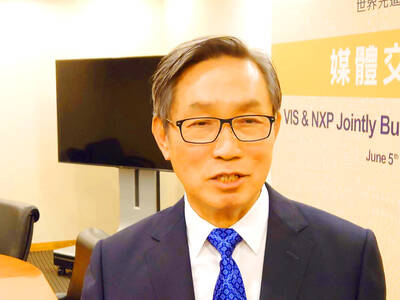The average selling price of DRAM chips next quarter is expected to decline by up to 8 percent quarter-on-quarter, with memory chips used in notebook computers and consumer electronics seeing the steepest decline due to excess inventory and a shortage of components, market researcher TrendForce Corp (集邦科技) said yesterday.
That means the DRAM industry is entering a new downcycle after experiencing a boom for three quarters, the longest uptrend in the history of the industry.
The Taipei-based researcher said it expects the balance between supply and demand to begin tilting toward a surplus in the final quarter of this year.
Most DRAM buyers are cautious about placing new orders, as their inventories have risen above safe levels, TrendForce said.
The average selling price of DRAM chips would slide between 3 and 8 percent next quarter from this quarter, the first decline since the first quarter of this year, it said.
The price of DRAM chips for laptops would fall between 5 and 10 percent, as a decline in demand for laptops would cause a PC DRAM chip surplus of 1.38 percent, TrendForce said.
Buying sentiment for Chromebooks is running out of steam, as students and workers are gradually returning to schools and offices after the US and European economies reopened, it said.
As PC makers have speculated that DRAM prices could weaken further, PC DRAM chip prices might decline more than 10 percent for some transactions next quarter, TrendForce said.
However, a slump in the PC DRAM segment would not likely trigger a large-scale downturn, as PC DRAM chips only account for a relatively small portion of major DRAM manufacturers’ total DRAM capacity, and chipmakers might allocate more capacity to server DRAM production amid steady server demand, it said.
The price of DRAM chips used in servers would remain the same or drop up to 5 percent next quarter, as growth momentum is slowing from the third quarter because US and Chinese cloud-server providers have ensured they have high inventory levels for eight to 10 weeks, the researcher said.
The price of DRAM chips used in consumer electronics would fall between 5 and 10 percent, as spending on home entertainment electronics is declining due to relaxed COVID-19 restrictions, it said.
Besides, a severe component shortage has led to lower shipments of TVs, set-top boxes and networking devices, as well as industrial devices, dragging down demand for DRAM chips, TrendForce said.
The price of DRAM chips used in mobile devices would be largely flat, but there is the likelihood of a decline due to high inventory levels ahead of the slack season in the first quarter, TrendForce said.
Demand for DRAM chips used in graphics cards looks resilient amid a recovery in cryptocurrency mining activities and robust demand for commercial laptop computers, TrendForce said, adding that the price of graphics card DRAM chips would be flat or drop 5 percent next quarter, it said.
Uneven supply of key components, including driver ICs, power management ICs and graphics cards is weakening buying sentiment, the researcher added.

TAKING STOCK: A Taiwanese cookware firm in Vietnam urged customers to assess inventory or place orders early so shipments can reach the US while tariffs are paused Taiwanese businesses in Vietnam are exploring alternatives after the White House imposed a 46 percent import duty on Vietnamese goods, following US President Donald Trump’s announcement of “reciprocal” tariffs on the US’ trading partners. Lo Shih-liang (羅世良), chairman of Brico Industry Co (裕茂工業), a Taiwanese company that manufactures cast iron cookware and stove components in Vietnam, said that more than 40 percent of his business was tied to the US market, describing the constant US policy shifts as an emotional roller coaster. “I work during the day and stay up all night watching the news. I’ve been following US news until 3am

Six years ago, LVMH’s billionaire CEO Bernard Arnault and US President Donald Trump cut the blue ribbon on a factory in rural Texas that would make designer handbags for Louis Vuitton, one of the world’s best-known luxury brands. However, since the high-profile opening, the factory has faced a host of problems limiting production, 11 former Louis Vuitton employees said. The site has consistently ranked among the worst-performing for Louis Vuitton globally, “significantly” underperforming other facilities, said three former Louis Vuitton workers and a senior industry source, who cited internal rankings shared with staff. The plant’s problems — which have not

TARIFF CONCERNS: The chipmaker cited global uncertainty from US tariffs and a weakening economic outlook, but said its Singapore expansion remains on track Vanguard International Semiconductor Corp (世界先進), a foundry service provider specializing in producing power management and display driver chips, yesterday withdrew its full-year revenue projection of moderate growth for this year, as escalating US tariff tensions raised uncertainty and concern about a potential economic recession. The Hsinchu-based chipmaker in February said revenues this year would grow mildly from last year based on improving supply chain inventory levels and market demand. At the time, it also anticipated gradual quarter revenue growth. However, the US’ sweeping tariff policy has upended the industry’s supply chains and weakened economic prospects for the world economy, it said. “Now

COLLABORATION: Given Taiwan’s key position in global supply chains, the US firm is discussing strategies with local partners and clients to deal with global uncertainties Advanced Micro Devices Inc (AMD) yesterday said it is meeting with local ecosystem partners, including Taiwan Semiconductor Manufacturing Co (TSMC, 台積電), to discuss strategies, including long-term manufacturing, to navigate uncertainties such as US tariffs, as Taiwan occupies an important position in global supply chains. AMD chief executive officer Lisa Su (蘇姿丰) told reporters that Taiwan is an important part of the chip designer’s ecosystem and she is discussing with partners and customers in Taiwan to forge strong collaborations on different areas during this critical period. AMD has just become the first artificial-intelligence (AI) server chip customer of TSMC to utilize its advanced